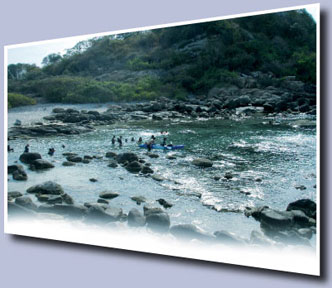

With the rising of the beautiful sun in the East heralding the dawn
of peace, we have to realize that Sri Lanka has natural wonders that are
in dire need of protection. As the East opens up for tourists and
domestic travellers after the peace, there are environmental concerns
over its natural wonders such as the Pigeon Island. Trincomalee, the
world’s natural harbour, and the green treasures around are now facing
environmental threat with plenty of travellers thronging as if they are
crazy.
 Witnessing the beauty of Mother Nature in the East as well as showing
it to your children is important but it should be done so as not to
destroy our natural treasures. Even though the Large Pigeon Island and
Small Pigeon Island were declared a sanctuary in 1963 and upgraded in
2003 to a National Park, many don’t seem to understand what that means.
On any given weekend, you see big shots, corporate organisations and
those from every social stratum flocking as birds to a place they want
to enjoy. What they don’t realize is that enjoying at the cost of Mother
Nature is not a thing to be happy about. Witnessing the beauty of Mother Nature in the East as well as showing
it to your children is important but it should be done so as not to
destroy our natural treasures. Even though the Large Pigeon Island and
Small Pigeon Island were declared a sanctuary in 1963 and upgraded in
2003 to a National Park, many don’t seem to understand what that means.
On any given weekend, you see big shots, corporate organisations and
those from every social stratum flocking as birds to a place they want
to enjoy. What they don’t realize is that enjoying at the cost of Mother
Nature is not a thing to be happy about.
According to the Sri Lanka Wetlands Information and Database (SLWID),
Pigeon Island National Park is made up of two small islands: large and
small Pigeon Island with plenty of rocky islets situated about one
kilometre off-shore. What is vital to be protected is the main Pigeon
Island reef which is home to 74 per cent of live hard coral cover where
25 per cent of soft corals dominate the rocky islets.
Over 100 species of corals and more than 300 species of reef fish
have been identified in the Trincomalee area, and many of these species
are found within the Pigeon Island National Park.
The SLWID, researched by IUCN (World Conservation Union), CEA
(Central Environmental Authority) and the IWMI (International Water
Management Institute) have even catalogued the endangered species such
as the protected reef fish ‘Labroides bicolor’ which has also been
spotted at the reef.
The globally critically endangered ‘Cheilinus undulates’ has also
been found in the reef depths and three species of globally endangered
marine turtles (Eretmochelys imbricata, Chelonia mydas and Lepidochelys
olivacea) frequent the reef.
According to the database, several species of birds either visit the
islands, which are an important breeding site for the wild race of
‘Columba livia’. Reef areas have extensive turf algae while the island
is dominated by dry zone scrub vegetation.
Initially, the name Pigeon Island came about in 1963 when emphasis
was made on protecting the birds especially the resident Blue Rock
Pigeon, for which it is named. However, while some tourists respect the
need to conserve environmental treasures, some don’t.
Tourists also state that it is the locals who offer services of
nature tours (in an unregulated manner) in order to make a quick buck.
According to the SLWID, uncontrolled tourism has resulted in pollution,
collection of corals and other marine organisms as souvenirs and
physical damage to the reef from boat anchoring and reef walking.
Extensive collection of ornamental species is also affecting populations
of some fish species.
Everybody is to be blamed if Pigeon Island is lost forever as the
locals indulge in destructive fishing practices. Despite local
communities being dependant on fishing as a source of income (many
traditional fishing techniques are still in use), it isn’t done in a
sustainable manner. If fish farming or alternative breeding techniques
could be used, then fisher folk don’t have to tamper with nature by
fishing in the reef.
 It is evident to see that there is common use of fish traps within
reef areas and beach seine nets are set up along the mainland coast near
Nilaveli. Some even use dynamite to break through the coral to get
better fish catches that is completely destroying the flora and fauna. It is evident to see that there is common use of fish traps within
reef areas and beach seine nets are set up along the mainland coast near
Nilaveli. Some even use dynamite to break through the coral to get
better fish catches that is completely destroying the flora and fauna.
Many hotels and guesthouses in the area are all turning a blind eye
to the destruction of nature all for the sake of money. Guest houses
have been mushrooming at a rate and after the dawn of the recent peace,
scuba diving operators are also having profitable stations. However, it
should be mentioned that some hotels have also tried to have beach and
reef clean-ups but it is like a marketing tool to attract more tourists.
A tourist who did not want his name mentioned said, “It is true that
the war has protected the nature around the area but even though the
rules are in place, many don’t adhere to them. The government should
enforce strict action on those who destroy nature or else it’ll be lost
forever.”
Sadly, even the Wildlife Conservation Department, the Central
Environmental Authority, the Environment Ministry and other government
authorities can’t help it if the people destroy nature themselves. It’s
high time we think of saving Pigeon Island right now before it becomes
another one-hit wonder like Hikkaduwa.
Pix courtesy Borderlands
|

